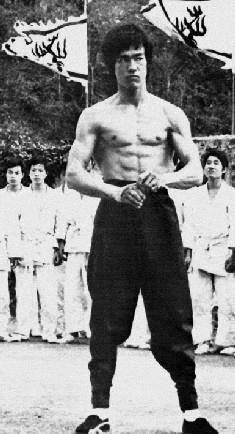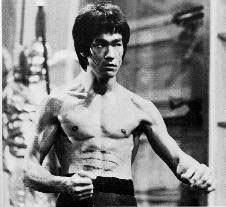by Brandon, 7/27/98
by Brandon, 7/27/98
 On July 20, 1973 Bruce Lee died. With the 25th anniversary re-release
of Lee’s post-mortum classic Enter the Dragon, complete with footage
not included in the original version, we are again reminded of the
continuing influence that this one man has on our lives.
On July 20, 1973 Bruce Lee died. With the 25th anniversary re-release
of Lee’s post-mortum classic Enter the Dragon, complete with footage
not included in the original version, we are again reminded of the
continuing influence that this one man has on our lives.
As a tribute to the life of Bruce Lee, the Asian American Arts Foundation (AAAF), with the Asian Art Museum and the Roxie Theater, hosted a benefit screening of Enter the Dragon. All proceeds from the event went to the AAAF Grants Program, which awards educational and financial grants to Asian American artists. I decided to make my contribution and forked out the 25 bucks for a ticket to join in on the festivities.
Before the movie, there was a reception, with food and drinks and some kick ass tunes from Jeff Chan & friends. I felt bad not knowing who the hell Jeff Chan was, especially since the band jammed everything from Santana to the Isley Brothers. If you are planning a party or a wedding, get these guys. They’ll turn it out for sure. Of course, everyone was huddled around the food, which actually wasn’t bad: the tastiest thing being the ribs and the most interesting being what looked like a rice crispy treat with shrimp paste on top (which I did eat, by the way). There was also a display of Bruce Lee memorabilia from Jeff Chinn, who apparently began his collection in 1972.
After we all funneled into the theater and found our seats, the program began. Being a martial artist, I sometimes lose perspective of Bruce Lee the man, and end up thinking of him as Bruce Lee the martial artist. I would guess that many of us do this because of our bias. But it’s important to remember who Bruce Lee was and what he stood for. Bruce Lee was born in San Francisco’s Chinatown. Educated at the University of Washington. Bruce Lee was Asian American.
The opening clip, "My name is Lee, Bruce Lee..." captured Lee in black
and white during what looks like a screen test. Is difficult to say what
is more impressive: his lighting fast speed as he demonstrates “gung fu”
or his charisma and eloquence. A performance by Filipina R&B divas Pinay
followed the clip. Entitled "Change in My Life," Pinay kicked it
acapella while images of Lee’s life and movie career were projected on
screen. Among them were Lee as Kato from the Green Hornet TV show. It’s
a shame that mainstream America in the 1960’s failed to allow the
talented Lee to be anything more than a sidekick. At the same time,
however, Lee made his mark on Asian America.
 The next performance, "I Remember Bruce" by Lane Nishikawa said it
best. Bruce Lee changed the image of the Asian man. He was strong,
handsome and kicked ass. At a time where Asian Americans had yet to
make a strong presence in popular American culture, Bruce gave us
something to be proud of. After decades of racism and the unfulfilled
American dream, the only images of Asians seen in American cinema and
television were Fu Man Chus and Hop Sings. Bruce changed that. He
became a role model and a cultural icon.
The next performance, "I Remember Bruce" by Lane Nishikawa said it
best. Bruce Lee changed the image of the Asian man. He was strong,
handsome and kicked ass. At a time where Asian Americans had yet to
make a strong presence in popular American culture, Bruce gave us
something to be proud of. After decades of racism and the unfulfilled
American dream, the only images of Asians seen in American cinema and
television were Fu Man Chus and Hop Sings. Bruce changed that. He
became a role model and a cultural icon.
With the mood set, we settled in for the movie. Growing up with Kung
Fu Theater on Channel 9 in Long Beach, I remember Enter the Dragon on
my parents ancient TV screen. Seeing it on the big screen, like the
rerelease of the Star Wars Trilogy, changes everything. There’s no need
to tell you about the movie; you’ve already seen it a dozen times. But
do yourself a favor and go see it again, on the big screen. Enter the Dragon
opens in San Francisco at the Roxie theater on July 31. Go celebrate the movie’s
25th anniversary and the life of Bruce Lee.